Fiche système d'assainissement 2023
CREON 2
Réseau de type Mixte
| Code de la STEP : | 0533140V004 |
|---|---|
| Nom du maître d'ouvrage de la STEP : | S.I.A.E.P.A. DE LA REGION DE BONNETAN |
| Nom de l'exploitant de la STEP : | SUEZ EAU FRANCE |
| Date de mise en service : | 01 avril 2014 |
| Date de mise hors service : | - |
| Niveau de traitement : | Secondaire bio (Ntk et Ngl) |
| Capacité : | 5 500 éq-hab. |
Raccordements communaux 10%..100% 10%..100% |

|

STEP
| Charge nominale DBO5 : | 330 Kg/j |
|---|---|
| Charge nominale DCO : | 660 Kg/j |
| Charge nominale MES : | 495 Kg/j |
| Débit nominal temps sec : | 825 m3/j |
| Débit nominal temps pluie : | - |
| Filières EAU : |
File 1 : Stockage avant traitement, Prétraitements, Boues activées faible charge, aération p, Bioréacteur à membrane, Lagunage de finition, Stockage avant rejet |
| Filières BOUE : |
File 1 : Stockage boues liquides File 2 : Centrifugation |
| Filières ODEUR : | - |
Point de rejet
| Coordonnées (Lambert 93) : | 434 800, 6 412 234 , Coordonnées établies (précision du décamètre) |
|---|---|
| Milieu récepteur : | Rivière : Ruisseau de Lubert- |
Chronologie des raccordements au réseau
 Déployer
Déployer
Observations SDDE 2023
| Système de collecte : Pas d'observation | |
| Station d'épuration : Pas d'observation | |
| Sous produits : Pas d'observation |
Données chiffrées
Les données présentées ci-dessous peuvent provenir des différentes STEP suivantes, liées au même système de collecte : 0533140V001 - CREONTableau de synthèse
Année d'activité 2023 - Possibilité de déversement par temps de pluie
| Paramètres | Pollution entrante | Rendement | Pollution sortante | |||
|---|---|---|---|---|---|---|
| Charge | % Capacité | Concentration | Charge | Concentration | ||
| VOL | 860 m3/j | 104 % | 868 m3/j | |||
| DBO5 | 221 Kg/j | 67 % | 270 mg/l | 99 % | 2,8 Kg/j | 3,2 mg/l |
| DCO | 480 Kg/j | 73 % | 584 mg/l | 96 % | 17 Kg/j | 20 mg/l |
| MES | 272 Kg/j | 327 mg/l | 98 % | 6,1 Kg/j | 6,1 mg/l | |
| NGL | 71 Kg/j | 83 mg/l | 91 % | 6,6 Kg/j | 7,6 mg/l | |
| NTK | 71 Kg/j | 83 mg/l | 96 % | 3,2 Kg/j | 3,8 mg/l | |
| PT | 7,5 Kg/j | 8,7 mg/l | 36 % | 4,8 Kg/j | 5,5 mg/l | |
Indice de confiance
| 2014 | 2015 | 2016 | 2017 | 2018 | 2019 | 2020 | 2021 | 2022 | 2023 | ||
| 3/5 | 3/5 | 3/5 | 3/5 | 3/5 | 3/5 | 3/5 | 3/5 | 3/5 | 3/5 |
Pollution traitée
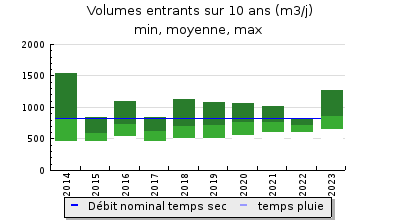


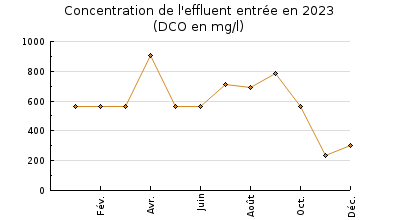

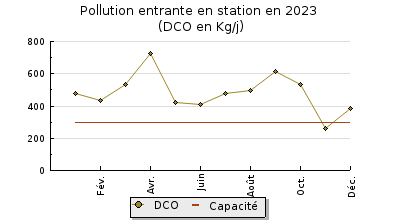
Pollution éliminée

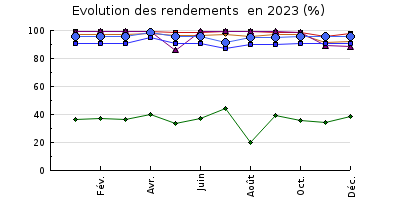
Pollution rejetée
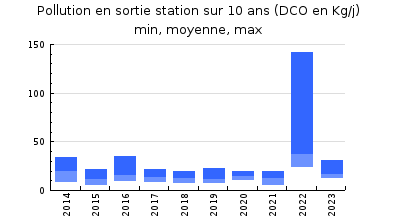


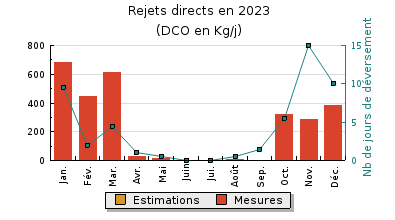
Production et destination des boues

Problèmes rencontrés en 2023
Aucun problème n'a été recensé en 2023
Accès aux données
Pour le système d'assainissement "CREON 2" :
Pour l'ensemble des systèmes d'assainissement du bassin, les données historiques sont disponibles en téléchargement depuis la thématique "Usages et pressions polluantes domestiques et urbaines" ou sous forme d'archive depuis le catalogue de données.
Autre source d'informations : la fiche du Portail d'information sur l'assainissement collectif

 Contact
Contact





 |
|